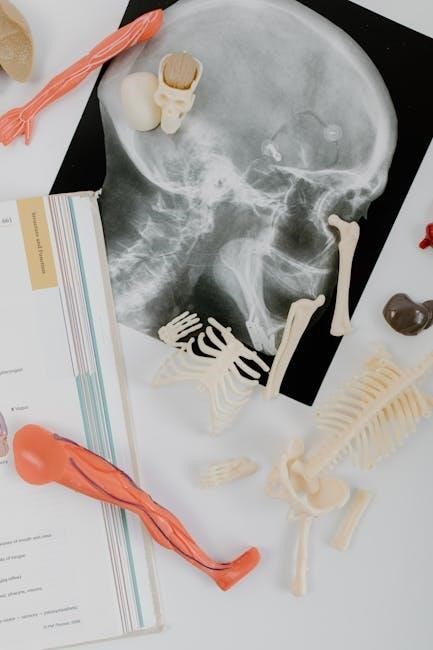The Biology Laboratory Manual, 12th Edition, serves as a key resource for students and educators, offering a comprehensive framework for hands-on biology education and practical skill development․
1․1 Overview of the Manual’s Role in Biology Education
The Biology Laboratory Manual, 12th Edition, plays a pivotal role in biology education by providing structured, hands-on activities that align with curriculum standards․ It serves as a comprehensive resource, bridging theory and practice, and supports educators in delivering engaging lessons․ The manual enhances students’ understanding and practical skills, making it an essential tool for modern biology education․
1․2 Target Audience and Purpose
The Biology Laboratory Manual, 12th Edition, is primarily designed for high school and undergraduate students, educators, and institutions․ Its purpose is to enhance biology education through structured experiments, aligning with curriculum standards and fostering practical skill development in a hands-on learning environment․

Content and Structure of the Manual
The 12th Edition is organized into logical sections, offering a structured approach to experiments, investigations, and activities that enhance hands-on learning and scientific inquiry skills effectively․
2․1 Key Features of the 12th Edition
The 12th Edition of the Biology Laboratory Manual offers updated experiments, enhanced digital resources, and a focus on hands-on learning․ It aligns with modern curriculum standards, providing a comprehensive framework for biology education․ The manual includes visual aids, interactive tools, and structured activities to engage students․ Designed for introductory courses, it covers a broad survey of biology, making it a valuable tool for both students and educators․
2․2 Organization of Experiments and Activities
The Biology Laboratory Manual, 12th Edition, is structured to align with introductory biology courses, offering a logical flow from basic to complex topics․ Experiments are categorized by biological disciplines, such as cell biology, genetics, and ecology․ Each activity includes clear objectives, materials lists, and step-by-step procedures․ Pre- and post-lab exercises, along with visual aids, enhance comprehension and critical thinking, ensuring a well-rounded learning experience for students․
Accessing the Biology Laboratory Manual in PDF Format
The Biology Laboratory Manual, 12th Edition, can be accessed in PDF format through authorized digital platforms, educational institutions, and select online retailers, ensuring convenient and legal access․
3․1 Sources for Downloading the 12th Edition PDF
The Biology Laboratory Manual, 12th Edition, can be accessed through authorized digital platforms, educational institutions’ libraries, or official publisher websites․ Additionally, online marketplaces like Amazon or eBay may offer PDF versions for purchase․ Some universities provide free access through their digital libraries․ Always ensure downloads are from trusted sources to avoid unauthorized or pirated copies․
3․2 Importance of Using Authorized Digital Platforms
Accessing the Biology Laboratory Manual 12th Edition via authorized platforms ensures legal compliance and high-quality content․ These platforms provide safe, reliable downloads free from malware, supporting creators through fair compensation․ They often include supplementary resources for enhanced learning․ Using unauthorized sources risks incomplete or corrupted files, potentially hindering academic progress and exposing users to security risks․

Experiments and Investigations in the Manual
The manual offers a diverse range of experiments, from cellular biology to ecology, designed to enhance practical understanding and critical thinking in biological sciences through hands-on exploration․
4․1 Types of Experiments Covered
The manual includes a wide range of experiments covering cell biology, genetics, ecology, and molecular biology․ It offers practical investigations into biological processes, such as DNA analysis and enzyme activity; Students engage in hands-on activities that promote scientific inquiry and critical thinking, aligning with modern educational standards and fostering a deeper understanding of biological principles․
4․2 Safety Precautions and Lab Protocols
The Biology Laboratory Manual, 12th Edition, emphasizes strict adherence to safety protocols to ensure a secure learning environment․ Students are required to wear protective gear, handle equipment carefully, and follow proper waste disposal procedures․ Specific precautions for each experiment are outlined to prevent accidents․ Emergency procedures, such as fire evacuation plans and first aid, are also detailed․ Instructors play a key role in enforcing these guidelines to maximize safety and learning outcomes․

Digital Resources and Supplements
The 12th Edition offers companion websites and interactive tools, providing students with online materials to enhance their learning experience and better understand complex biological concepts through engaging multimedia content․
5․1 Companion Websites and Online Materials
The Biology Laboratory Manual 12th Edition is supported by companion websites offering digital resources, including interactive simulations, video tutorials, and downloadable materials․ These online platforms enhance learning by providing visual aids and multimedia elements․ Many universities and publishers also offer free access to these resources through their digital libraries, ensuring students can supplement their lab work effectively with online tools and guides․
5․2 Interactive Tools for Enhanced Learning
The 12th Edition of the Biology Laboratory Manual incorporates interactive tools to enrich the learning experience․ These include virtual lab simulations, quizzes, and interactive diagrams that allow students to explore complex biological concepts visually․ Such tools cater to diverse learning styles, making abstract ideas more accessible and engaging․ They also encourage active participation, fostering a deeper understanding of biological principles and their practical applications․

The Role of the Manual in Modern Biology Education
The Biology Laboratory Manual, 12th Edition, plays a crucial role in modern education by aligning with curriculum standards and fostering hands-on, inquiry-based learning experiences․
6․1 Aligning with Curriculum Standards
The Biology Laboratory Manual, 12th Edition, is designed to align with modern curriculum standards, ensuring comprehensive coverage of essential biological concepts․ It incorporates updated experiments and activities that meet educational frameworks, providing students with practical experiences that reinforce theoretical knowledge․ The manual also includes assessments and exercises to evaluate understanding, making it a valuable resource for structured learning outcomes in biology education․
6․2 Fostering Hands-On Learning Experiences
The 12th Edition of the Biology Laboratory Manual emphasizes practical engagement, allowing students to explore biological concepts through structured experiments and activities․ By focusing on hands-on experiences, the manual encourages critical thinking and problem-solving, aligning with modern educational standards to enhance scientific literacy and prepare students for real-world applications in biology․
Troubleshooting Common Issues in Lab Experiments
Troubleshooting in lab experiments involves identifying and addressing errors, ensuring safety, and optimizing results․ The manual provides guidelines to help students and educators resolve common experimental challenges effectively․
7․1 Identifying and Addressing Experimental Errors
Recognizing and correcting experimental errors is crucial for accurate results․ Common mistakes include improper measurement, incorrect reagent use, and deviation from protocols․ Careful preparation, double-checking materials, and adhering to safety guidelines minimize errors․ The manual emphasizes troubleshooting techniques and data analysis to identify discrepancies, ensuring reliable outcomes and fostering a deeper understanding of scientific processes․
7․2 Maximizing Learning Outcomes Through Problem-Solving
Maximizing learning outcomes through problem-solving involves addressing experimental challenges, fostering critical thinking, and enhancing practical skills․ By resolving issues, students deepen their understanding and apply theoretical concepts to real-world scenarios, improving overall educational outcomes․ This approach encourages independent research, collaboration, and adaptability, preparing learners for future scientific endeavors and reinforcing their ability to tackle complex biological questions effectively․

Supplementary Materials for Advanced Learning
The 12th Edition offers additional resources for in-depth study, including companion websites and interactive tools, fostering independent research and exploration beyond the core manual content․
8․1 Additional Resources for In-Depth Study
The 12th Edition of the Biology Laboratory Manual is complemented by online libraries and educational platforms offering supplementary materials․ These include detailed guides, interactive simulations, and downloadable PDF resources like the Biology Lab Manual Class 12․ Such tools enhance understanding and encourage independent exploration, providing students with a richer learning experience beyond the manual’s core content․
8․2 Encouraging Independent Research and Exploration
The manual’s structured format and comprehensive resources empower students to delve into independent research, fostering a deeper understanding of biological concepts․ By providing detailed procedures and access to digital tools, it encourages learners to explore beyond classroom experiments, promoting scientific inquiry and critical thinking․ This approach helps students develop essential skills for advanced study and real-world applications in biology․

Best Practices for Using the Manual Effectively
Engage with pre-lab activities, review multimedia elements, and organize digital content for easy access to maximize learning and practical application of the manual’s resources effectively․
9․1 Engaging with Pre-Lab and Post-Lab Activities
Pre-lab activities, such as reading and planning, ensure students understand objectives and materials․ Post-lab exercises, like data analysis and reflection, reinforce learning and critical thinking․ These structured steps in the Biology Laboratory Manual, 12th Edition, enhance hands-on experiences, preparing students for experiments and fostering deeper comprehension of biological concepts through active participation and thorough review․
9․2 Leveraging Visual Aids and Multimedia Elements
The 12th Edition incorporates visual aids and multimedia elements to enhance learning․ These include simulations, videos, and 3D models that simplify complex concepts․ Interactive graphs and charts allow students to explore data dynamically․ Additionally, interactive quizzes and virtual lab tours provide hands-on practice, making the manual a comprehensive tool for engaged and effective learning․
The Biology Laboratory Manual, 12th Edition, remains a foundational resource, evolving to meet modern educational demands and integrate emerging technologies for enhanced learning experiences in biology education․
10․1 The Evolution of Biology Lab Manuals
The Biology Laboratory Manual, 12th Edition, reflects the evolution of lab manuals from static textbooks to dynamic, interactive resources․ Over the years, these manuals have incorporated digital tools, multimedia, and updated experiments to align with modern educational needs․ The 12th Edition exemplifies this transformation, offering a comprehensive framework that bridges traditional laboratory practices with innovative learning methods, making it a cornerstone of contemporary biology education․
10․2 Adapting to Emerging Trends in Science Education
The Biology Laboratory Manual, 12th Edition, aligns with modern educational trends by integrating digital simulations, real-time data analysis, and eco-friendly laboratory practices; It emphasizes inquiry-based learning and collaborative experiments, fostering critical thinking and teamwork․ The manual also incorporates virtual labs and interactive multimedia, catering to diverse learning styles and preparing students for future scientific advancements in a rapidly evolving field․
